The latest news, trends, analysis, interviews and podcasts from the global food and beverage industry

Discover how the Internet of Things (IoT) is revolutionising industries worldwide. Paul Marshall, chief commercial officer at Eseye, provides insights into the current trends, challenges and future possibilities within the IoT space, offering valuable perspectives for agritech and smart farming businesses looking to harness its potential for competitive advantage.
In the ever-evolving field of 21st-century agriculture, technology is making rapid strides, particularly through the increasing integration of IoT. This digital revolution goes beyond technological innovation; it represents a crucial evolution aimed at addressing the challenges faced by modern agriculture.
IoT in agritech has delivered transformative solutions that boost productivity, optimise resource management and minimise environmental impact. This technology ushers in a new era of smart farming, where data-driven decisions enhance crop yields and improve farming practices.
The integration of IoT into agritech is revolutionising not only farming practices but also the broader approach to food production and management. Recent studies, including a thorough analysis by Berg Insights, shed light on trends and future directions for agricultural IoT applications.
According to Berg's research, the number of wireless devices in this sector is projected to grow at a robust compound annual growth rate (CAGR) of 8.1%, increasing from 25.2 million connections in 2022 to an impressive 37.1 million by 2027. Furthermore, cellular connections, which stood at 1.8 million at the end of 2022, are expected to rise at a CAGR of 17.7%, reaching 4.0 million by 2027, indicating significant growth in connectivity solutions for agriculture.
Bridging traditional farming with modern technology
Agriculture is the cornerstone of human civilisation. Yet at the same time, it is one of the most vulnerable sectors to the vagaries of our ever changing weather patterns, nature’s response to these patterns and economic fluctuations.
This is where IoT steps in to bridge the gap between traditional farming techniques and cutting-edge technology, creating a sustainable, productive and more efficient practice known as smart farming. This clever integration holds the door open for an industry battling to keep up with not only climate change, and diminishing natural resources, but with rapid population growth.
IoT in agriculture empowers farmers to overcome challenges providing them with a network of sensors, drones, autonomous vehicles, and automated hardware, all connected via the cloud. Networks collect and analyse vast amounts of data from the field, such as soil moisture levels, crop health, weather conditions and equipment status providing farmers with actionable insights allowing them to make informed and accurate decisions.

Enhancing crop management and yield
One of the most significant advantages of IoT in agriculture is its role in enhancing crop management. Sensors are strategically placed in fields to measure a breadth of essential parameters, including temperature, rainfall, humidity, wind speed, pest infestation and soil pH.
Real-time data, collected with precision and stored securely, is only accessible to authorised personnel. This ensures that farmers can monitor crop health and environmental conditions with confidence, without the need for physical presence in the field.
Drones equipped with high-resolution cameras offer farmers aerial views, allowing the gathering of real-time data across large areas. This helps them assess crop health and spot potential problems before they become too widespread. It also increases the accuracy of crop monitoring and maintenance and the potential for financial benefits.
Optimising resource use and sustainability
One of the most pressing issues in agriculture is water management, particularly in arid regions with unpredictable rainfall. Here, IoT comes to the rescue with smart irrigation systems that adjust watering schedules and volumes based on real-time data from soil sensors. This reduces water wastage and ensures optimal plant growth.
Additionally, IoT applications enable precise pesticide and fertiliser application, minimising runoff and pollution. This practical application of IoT is a significant step towards sustainable farming.
Boosting farm operational efficiencies
IoT has the potential to revolutionise farm management by automating routine tasks saving valuable workforce time. For instance, smart tractors and farm vehicles equipped with GPS and IoT connectivity can perform tasks like seeding, ploughing, and harvesting more efficiently and autonomously.
This advanced automation reduces the reliance on scarce and expensive manual labour, making farming practices more scalable and less prone to costly errors.
Yet IoT technology has not saved agriculture by reducing labour and maintaining crop health alone. It has facilitated predictive maintenance of farm equipment. Sensors can predict equipment failures before they occur, thus minimising downtime and high repair costs.
The transformative power of IoT in smart farming lies in its ability to convert vast amounts of data into actionable insights. This shift in farming practices, from decisions based on years of experience to data-driven decisions, is a game-changer. With information on micro-climate conditions and crop ripeness, farmers can now make informed decisions backed by real-time data and analysis.

Challenges and the road ahead
While promising, the global integration of IoT in agriculture faces significant challenges, including not only high initial costs but also device management complexities and data security concerns.
Overcoming these hurdles requires robust rural internet connectivity to ensure effective data transmission. The future of smart farming could be revolutionary, not merely enhancing traditional practices but also transforming them by integrating IoT with advanced technologies like AI and machine learning.
As businesses innovate and policymakers support these sustainable practices, the potential of IoT in agriculture to secure food and environmental sustainability becomes not only increasingly critical but viable, signalling a paradigm shift in agricultural methods and a brighter future for global food security.
#Opinion #IoT #InternetofThings #Agriculture #Farming











